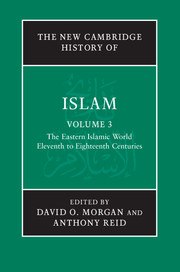Book contents
- Frontmatter
- Introduction: Islam in a plural Asia
- PART I THE IMPACT OF THE STEPPE PEOPLES
- 1 The steppe peoples in the Islamic world
- 2 The early expansion of Islam in India
- 3 Muslim India: the Delhi sultanate
- 4 The rule of the infidels: the Mongols and the Islamic world
- 5 Tamerlane and his descendants: from paladins to patrons
- PART II THE GUNPOWDER EMPIRES
- PART III THE MARITIME OECUMENE
- PART IV THEMES
- Glossary
- Bibliography
- Index
- References
5 - Tamerlane and his descendants: from paladins to patrons
from PART I - THE IMPACT OF THE STEPPE PEOPLES
Published online by Cambridge University Press: 28 March 2011
- Frontmatter
- Introduction: Islam in a plural Asia
- PART I THE IMPACT OF THE STEPPE PEOPLES
- 1 The steppe peoples in the Islamic world
- 2 The early expansion of Islam in India
- 3 Muslim India: the Delhi sultanate
- 4 The rule of the infidels: the Mongols and the Islamic world
- 5 Tamerlane and his descendants: from paladins to patrons
- PART II THE GUNPOWDER EMPIRES
- PART III THE MARITIME OECUMENE
- PART IV THEMES
- Glossary
- Bibliography
- Index
- References
Summary
Introduction
The nearly simultaneous dissolution of the Mongol successor states of the Ilkhans in Iran, the Chaghadayids in Central Asia and the Golden Horde in the Qıpchaq, or Eurasian, steppe during the fourteenth century was paralleled in the far east by the unravelling of the Mongol Yuan dynasty in China, and in the far west by the eventual displacement of the Bahri Mamlūk state in Egypt by its Circassian counterpart. These political developments following the period of the great pax mongolica, which under the Chinggisid dispensation had brought together east and west, Turk and Iranian, Arab and Mongol in a vast international mercantile and cultural enterprise, resulted in the creation of what has traditionally been viewed as a political vacuum, particularly in the eastern Islamic world, and they mark the transition between the beginning and end of what Marshall Hodgson referred to as the Islamic Later Middle Period (1250–1500). See Map 3 for this chapter.
With the death of the last Ilkhanid ruler, Abū Sa’īd, in 736/1335, greater Iran and Central Asia became the arena for competing political factions, some of which succeeded in establishing local control in the form of dynastic states. Originally a Mongol tribe in Ilkhanid service, the Jalayirids established themselves in north-western Iran and Iraq, eventually prevailing over their rivals, the Chopanids. The Muzaffarids, who were of Arab descent, carved out a political niche for themselves in southern and western Iran, in the process absorbing the short-lived dynasty of the Injuids, who ruled over Fārs.
- Type
- Chapter
- Information
- The New Cambridge History of Islam , pp. 169 - 200Publisher: Cambridge University PressPrint publication year: 2010

